Uttar Pradesh
Beyond Bulldozers: Can Yogi Build Banke-Bihari Corridor Without Compromising It's Sanctity?
Nishtha Anushree
Jul 07, 2025, 02:29 PM | Updated 02:31 PM IST
Save & read from anywhere!
Bookmark stories for easy access on any device or the Swarajya app.

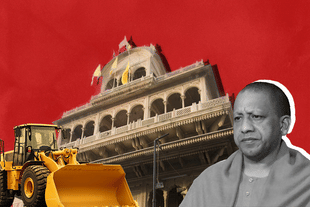
Bulldozers will have to carve the path for the construction of the ambitious Banke Bihari corridor in Vrindavan, Mathura, much like they did for the Kashi Vishwanath corridor in Varanasi a few years ago.
There, too, there was opposition to the demolitions, though not to the scale that Uttar Pradesh (UP) Chief Minister (CM) Yogi Adityanath is set to face in Vrindavan, ever since the UP government took over the temple.
Bulldozers have become synonymous with Yogi's identity, as his government has carried out several demolitions of illegal structures linked to rioters or certain criminal accused to deliver 'quick justice'.
While the Supreme Court has criticised 'bulldozer justice' and sought to restrain it by setting conditions for any demolition activity, it has not impacted Yogi's public image as 'bulldozer baba'.
CM Yogi is widely known as 'bulldozer baba', and images of him with JCBs in memes and posters have further popularised this portrayal, cementing his reputation as a firm and no-nonsense leader.
However, this same image makes him susceptible to being pigeonholed with the bulldozer symbol, especially regarding the Banke Bihari corridor, thereby increasing resistance to his initiatives.
The need for the Banke Bihari corridor
While the Banke Bihari temple has long struggled with overcrowding, the need for a corridor became urgent after the August 2022 stampede on Janmashtami, which killed and injured several devotees.
Subsequently, a Public Interest Litigation (PIL) was filed in the Allahabad High Court, highlighting the temple’s spatial constraints, inadequate pathways, and lack of crowd management systems, and seeking government intervention.
Notably, the Banke Bihari temple is confined to an area of just 1,200 square feet, with no proper exits, clean paths, or crowd control measures. Despite this, 40,000 to 50,000 devotees visit daily. On weekends and festivals, the footfall reaches lakhs; on Janmashtami, it can exceed 5 lakh.
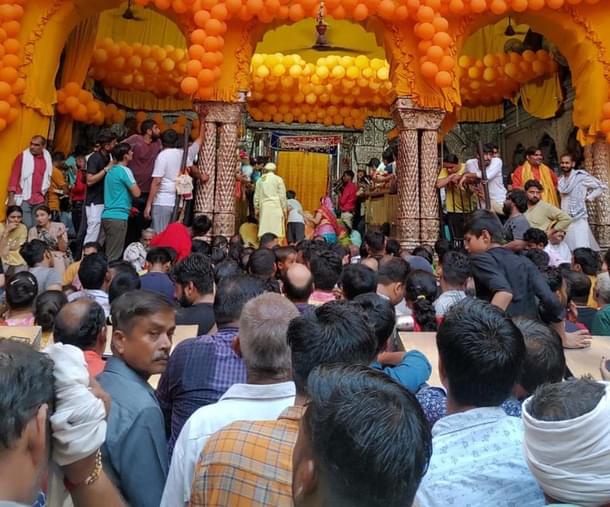
The numbers pose significant risks without crowd management. In response to the PIL, the UP government proposed a development scheme to expand the area around the temple, adding essential facilities such as parking, restrooms, and security checkpoints to enable safer darshan.
However, the plan had to pass a prolonged legal battle, from the High Court to the Supreme Court, to secure permission for acquiring land and constructing a corridor to deal with overcrowding.
Following the Supreme Court's greenlight on 15 May, the UP government assumed control of the temple on 26 May through an ordinance, establishing the Banke Bihari Ji Mandir Nyas, a trust comprising seven ex-officio and 11 nominated members.
The plan for the Banke Bihari corridor
The plan entails acquiring 5 acres of land around the temple and building a corridor on the lines of Kashi Vishwanath, to decongest the narrow lanes, streamline pilgrim movement, and create a grand temple plaza with supporting infrastructure.
This plaza will include waiting areas for pilgrims, dedicated lanes for VIPs, the elderly, and emergency services, rest zones, drinking water points, toilet blocks, a museum, and an interpretation centre on Braj culture and Krishna bhakti. The temple's capacity will be increased to accommodate 10,000 devotees at a time.
Execution of the corridor will be overseen by the newly formed trust, which includes Mathura's District Magistrate (DM), the Senior Superintendent of Police (SSP), the Municipal Commissioner, the CEO of the UP Braj Teerth Vikas Parishad (UPBTVP), an officer from the Department of Religious Affairs, and the government-appointed CEO of the trust.
The project requires the demolition of over 300 properties and the displacement of nearly 275 families. A rehabilitation plan has been proposed, offering resettlement in Rukmani Vihar and Sunrakh Bangar, along with residential schemes, shops within the corridor, or compensation.
Despite these plans, opposition has emerged, largely from the Goswami Sevayats who have managed temple affairs for generations, and from concerns over preserving the religious sanctity of the narrow streets, known as Kunj Galiyan, surrounding the temple.
The opposition
Following the government's takeover of the Banke Bihari temple, women from the Sevayat Goswami community began protesting against the corridor plan. They paused only after assurances from Mathura Member of Parliament (MP) Hema Malini.
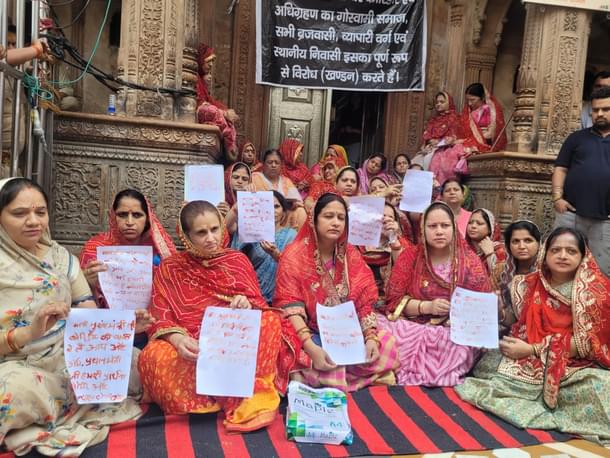
The Bharatiya Janata Party (BJP) MP has assured them that their concerns would be raised before CM Yogi and addressed efficiently, and appealed for their support for the temple corridor.
While the sit-in protests have come to a halt for now, the Goswami community continues to protest against the corridor plan and has been engaged by the administration in various meetings to address their concerns.
The major concern of the Goswamis is that the government takeover would diminish their role in temple management, alienating them from their family tradition, which has continued since Swami Shri Haridas, who established the Banke Bihari temple in the 19th century.
The government has assured that it will not interfere in temple traditions in any way and the worshipping rituals of the Goswami community will continue. Despite these assurances, the Goswami community is against the corridor plan.
Critics allege their resistance stems from vested interests. “They (Goswamis) take money in the name of VIP darshan. They are a kind of darshan mafia,” local resident Nishant Aggarwal told Swarajya.
“They have made it difficult for ordinary people to have darshan, but if one pays, they facilitate it. It's business in the name of god. Meanwhile, they have done nothing to improve pilgrim facilities,” he added.
Most of the shops around the temple are also owned by the Goswami community and have been rented out. The construction of the corridor will result in these shops being relocated or demolished, affecting their income and fuelling discontent.
Another concern is that displacement would hinder their ability to serve the temple as conveniently as before, and thus they resist vacating their traditional premises.
A further objection is that the corridor will commercialise the sacred space around the temple. The Goswamis wish to preserve the Kunj Galiyan, the narrow lanes around the temple, with the belief that Lord Krishna spent his time here.
The assurances
Mathura DM Chandra Prakash Singh told Swarajya that no Kunj Gali would be demolished, and stressed that the administration is committed to addressing all concerns while executing the development plan.
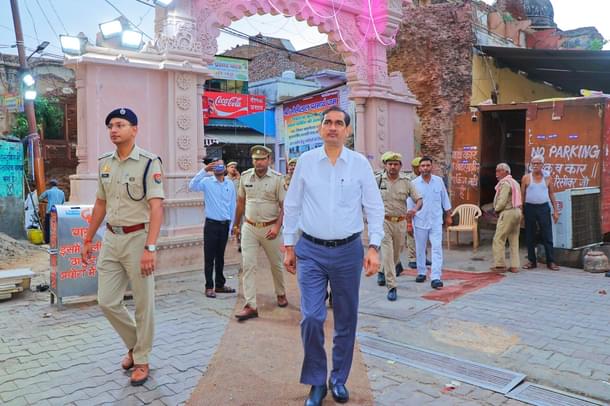
“We are acquiring 4.74 acres of land. This land parcel does not involve any main roads, and hence no Kunj Gali will be affected,” said the DM, adding that most stakeholders are open to the government’s proposal.
While declining to disclose compensation and rehabilitation, until a deal is finalised, he said, "We are taking people’s properties, so we must ensure good compensation and employment opportunities. We have plans in place and are optimistic of reaching a resolution."
Regarding Goswami protests, he said: "We are in discussions and trying to persuade them. It’s a sacred initiative, and I’m hopeful they will come around.They have certain reservations and we will address them."
Similar assurances came from BJP MP Hema Malini, who said: “They have been assured that no one will be relocated outside Vrindavan. The administration is making provisions within Vrindavan.”
CM Yogi later met a delegation of saints and assured them that the newly formed trust would include only members aligned with Vaishnav traditions, and that the rights of traditional Goswami Sevayats would remain intact.
Notably, as per the trust’s structure, it will have three representatives each from Vaishnav traditions, other branches of Sanatan Dharma, and from among scholars, educators, entrepreneurs, and social workers associated with Hindu society.
To ensure representation of the traditional Goswami Sevayats, the trust will include two descendants of Swami Shri Haridas, one representing the Raj Bhog Sevayats and the other the Shayan Bhog Sevayats. Their selection will be based on nominations received through an established process.
The difficult way ahead
Despite these reassurances, the road ahead remains challenging due to the religious sensitivities the project touches upon and the sentiments attached to the temple’s surroundings.
Comparable issues arose during the Kashi corridor’s development, where the government successfully cleared densely packed structures while preserving ancient temples nestled within private properties.
However, unlike in Varanasi, no specific religious community opposed the project. In Vrindavan, the Goswami community’s resistance adds complexity. In Kashi, the government dealt primarily with local property owners, offering rehabilitation and compensation.
Resistance in Vrindavan is also compounded by the recent government takeover of the Banke Bihari temple. By contrast, the Kashi Vishwanath temple has been under government administration for decades, precisely since 1983 when the government established a trust to manage temple affairs.
Adding to the challenge is the absence of a strong public figure championing the project. Although leaders like Hema Malini are involved, none command the same charisma and authority as Prime Minister Narendra Modi, who spearheaded the Kashi corridor.
Being an MP from Varanasi, the Kashi corridor was a pet project of PM Modi and he supervised it directly throughout the project duration. For the Banke Bihari corridor to succeed, CM Yogi must step into a similar leadership role.
Yet, Yogi’s 'Bulldozer Baba' image risks reducing every project involving enforcement to an act of destruction, overshadowing the intended transformation with its broad walkways and modern amenities, to take root in public perception.
This perception will be the most challenging part to deal with. This perception will be the hardest to shift. CM Yogi will require a capable administrative team, much like Vishal Singh, who was instrumental as CEO of the Kashi corridor trust in assisting PM Modi in the ambitious task.
The early progress
It has been just over a month since the UP government took charge of the Banke Bihari temple. The progress on the corridor gained pace after CM Yogi's special adviser Awanish Kumar Awasthi visited Vrindavan on 6 June.
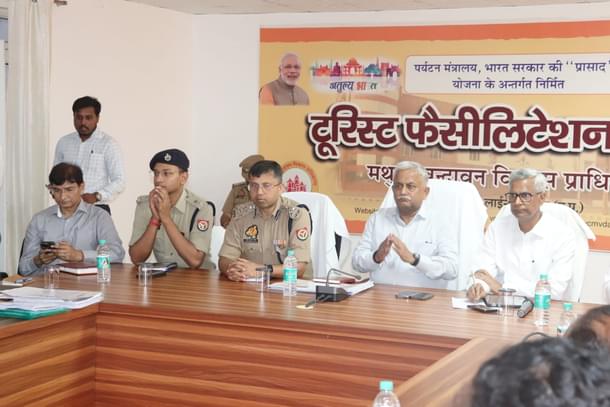
Awasthi and UPBTVP vice-chairperson Shailja Kant Misra declined to comment, citing the confidentiality expected during the project’s early phase.
Nonetheless, the district administration has held several meetings to discuss the corridor internally and with stakeholders, aiming to build consensus and secure cooperation.
Agra Divisional Commissioner (the division under which Mathura-Vrindavan falls) Shailendra Kumar Singh and Deputy Inspector General (DIG) Shailesh Kumar Pandey are leading these meetings at the regional level.
So far, they have met architects for the corridor design, local traders, priests of local temples, prominent citizens of the area, kathavachak Devkinandan Thakur and the Sevayats of the Banke Bihari temple to garner their support.
During Awasthi’s visit, a joint meeting was held with Goswamis, intellectuals, shopkeepers, and residents. Various women’s and Hindu organisations, along with UPBTVP, have expressed support for the initiative.
After site inspections, officers met CM Yogi in Lucknow to discuss the plan for the corridor. At the local level, the DM and SSP continue to engage with property owners for land acquisition.
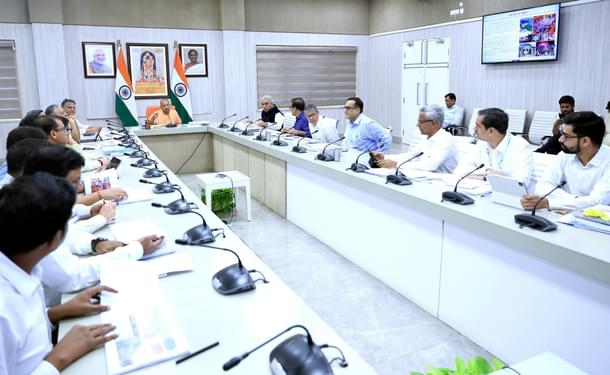
Speaking to Swarajya, Mathura DM Singh declined to share figures on how many owners have agreed so far but indicated that most are onboard and formal agreements would be signed soon.
The work of the district administration is majorly land acquisition. Once this is done, the Banke-Bihari trust will take over construction responsibilities.
However, apart from the ex-officio members, the list of nominated trustees is yet to be announced. Crucially, the trust’s CEO will play a central role, and hence, all eyes are on these appointments, making that appointment one to watch closely.
Why Yogi needs to do it
As the race to succeed PM Modi gathers momentum, CM Yogi must position himself as a well-rounded leader, not merely an enforcer, if he intends to be a serious contender at the national level.
The Banke Bihari corridor offers a prime opportunity to do so. The project demands not just decisiveness but also the felxibility, ability to listen, accommodate, and lead with nuance to satisfy as many stakeholders as possible.
PM Modi has set an example how a leader must evolve with time. Once seen as a hardline Hindutva figure when he was Gujarat CM, today PM Modi is widely recognised as a development-oriented, globally respected statesman.
Similarly, for a national role, Yogi must broaden his persona, from a decisive administrator who prioritises law and order, to a visionary capable of balancing faith, development, and governance.
As the Kashi corridor is regarded as PM Modi’s legacy, the Banke Bihari corridor could become Yogi’s, if he plays his cards right and surrounds himself with competent and trustworthy administrators.
Nishtha Anushree is Senior Sub-editor at Swarajya. She tweets at @nishthaanushree.





